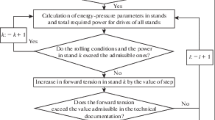Abstract
Minimization of the power consumed in the continuous cold rolling of steel by means of an optimized algorithm is considered, as part of the design of an effective production technology. A universal algorithm is developed for the optimization of the technology in terms of minimum energy expenditure. This algorithm simplifies and speeds up engineering calculations employed by sheet-rolling specialists. We consider the application of the algorithm to an example.
Similar content being viewed by others
References
Khimich, G.L. and Tslyuk, M.B., Optimizatsiya rezhimov kholodnoi prokatki na ETsVM (Optimization of Cold Rolling Modes Using an Electronic Digital Machine), Moscow: Metallurgiya, 1973.
Skorokhodov, A.N., Optimizatsiya prokatnogo proizvodstva (Optimization of Rolling Production Facilities), Moscow: Metallurgiya, 1983.
Genkin, A.L., Modelirovanie i optimizatsiya protsessa goryachei prokatki polos (Modeling and Optimization of Hot Rolling of Metal Strips), Moscow: Lenand, 2012.
Zamani, D., Golshan, A., Dini, G., et al., Optimization of cold rolling and subsequent annealing treatment on mechanical properties of TWIP steel, J. Mater. Eng. Perform., 2017, vol. 26, no. 8, pp. 3666–3675.
Garber, E.A., Shalaevskii, D.L., and Mitrofanov, A.V., Optimization of the technological mode of a broadband hot rolling mill according to the criterion of “minimum power consumption,” Mekh. Oborud. Metall. Zavodov, 2016, no. 1 (6), pp. 3–9.
Garber, E.A., Aleshin, A.E., Degtev, S.S., and Traino, A.I., Optimization of the technological and thermal conditions in a reversing cold rolling mill, Russ. Metall. (Engl. Transl.), 2015, vol. 2015, no. 1, pp. 30–35.
Garber, E.A., Nikitin, D.I., Shadrunova, I.A., and Traino, A.I., Calculation of the cold-rolling power with allowance for the variable work of friction along a deformation zone, Russ. Metall. (Engl. Transl.), 2003, vol. 2003, no. 4, pp. 340–346.
Ćurčija, D. and Mamuzić, I., Optimization process of strip cold rolling, Metalurgija, 2005, vol. 44, no. 3, pp. 221–226.
Malik, A.S., Rolling mill optimization using an accurate and rapid new model for mill deflection and strip thickness profile, PhD Thesis, Dayton: Wright State Univ., 2007.
Safari, M. and Moghoomi, M., Optimization of force and power imposed on continuous tandem cold rolling rollers using a multiple-function genetic algorithm, Open Access Libr. J., 2015, vol. 2, no. 4, art. ID 68341.
Kozhevnikov, A.V., Kozhevnikova, I.A., and Bolobanova, N.L., Simulation of cold-rolling process in dynamic conditions, Metallurgist, 2017, vol. 61, nos. 7–8, pp. 519–522.
Kozhevnikov, A.V., Kozhevnikova, I.A., and Bolobanova, N.L., Dynamic model of cold strip rolling, Metalurgija, 2018, vol. 57, nos. 1–2, pp. 99–102.
Author information
Authors and Affiliations
Corresponding author
Additional information
Original Russian Text © A.V. Kozhevnikov, V.N. Volkov, 2018, published in Stal’, 2018, No. 4, pp. 33–35.
About this article
Cite this article
Kozhevnikov, A.V., Volkov, V.N. Determining the Energy Expenditures in Continuous Cold Rolling. Steel Transl. 48, 252–255 (2018). https://doi.org/10.3103/S0967091218040058
Received:
Published:
Issue Date:
DOI: https://doi.org/10.3103/S0967091218040058




